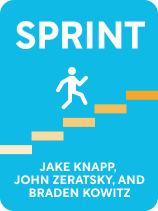

This article is an excerpt from the Shortform book guide to "Sprint" by Jake Knapp, John Zeratsky, and Braden Kowitz. Shortform has the world's best summaries and analyses of books you should be reading.
Like this article? Sign up for a free trial here.
What is the How Might We (HMW) method? How should you use the HMW method in a design sprint workshop?
Jake Knapp invented the Design Sprint process while working for Google and later facilitated sprints with over a hundred companies, including Slack, Airbnb, and Spotify. According to him, using the How Might We method of questioning is one of the keys to a successful design sprint workshop.
Read on to learn how to use the How Might We method in your sprint workshop, according to Knapp.
Sprint Design & the “How Might We” Method
According to Sprint author Jake Knapp, organizing short interviews with anyone who might have insights to offer on your design sprint project is a key step of the sprint workshop. He further advises using the How Might We (HMW) method to structure your interviews.
Knapp argues that no one person understands everything it takes to create and sell your product, so this time gives the whole team a chance to hear from every knowledge specialty represented at your company. By the end, every member of the team should have a well-rounded understanding of what’s involved in the development of your product. Through your questioning, the interviewees should close any gaps of knowledge about the project.
As you’re listening to the interviewees, the authors advise that all members of the team should write compelling points they hear on sticky notes: primarily things the team needs to reconsider or add to the flowchart and list of questions.
Write each observation as a question on its own sticky note, starting with the phrase “How might we…?”. The How Might We method places emphasis on the opportunity for growth and solutions, rather than the prevalence of problems and challenges. Here is an example of what this might look like for the bookstore team:
- Observation: It’s hard to make a web-based recommendation tool feel personalized because there’s no real human interaction involved.
- Question: How might we introduce a personalized human element into an online recommendation tool?
When the interviews are over, have all members of the team place their How Might We sticky notes on a wall in any order. Then, work together to reorganize the notes into themes. Let the themes appear naturally, rather than naming them before you start organizing the notes.
Give each team member two dot stickers (except for the team leader, who gets four). Place your dots next to the How Might We questions that seem most important to address. Take all of the sticky notes that have multiple dots on them and place them on your customer experience flowchart next to the step they best apply to.
| The History and Importance of the How Might We Method The How Might We (HMW) method of questioning was invented by business consultant Min Basadur in the 1970s. Basadur created this method while consulting for Procter & Gamble (P&G). The company was trying to create a better version of rival Colgate-Palmolive’s Irish Spring soap, and Basadur had them ask the question, “How might we create a refreshing soap of our own?” After that, the P&G team started generating hundreds of ideas, and the How Might We method was formed. Since then, companies like IDEO, Facebook, and Google have employed How Might We questions to solve problems and spark innovation in their own projects. The method is consistently successful and popular because of its intentional structure. The “how” acknowledges that it’s possible to answer whatever question you’re asking. The “might” introduces flexibility—your solutions might succeed in answering the question, or they might fail. The phrasing is purposefully neutral to allow for any outcome. Finally, the “we” makes it a collective process, indicating that you and your team will work together to solve the problem—even if, as in the authors’ process here, one person makes the ultimate decision about how to proceed. |
Narrow Your Sprint’s Focus
The last task Knapp, Zeratsky, and Kowitz outline for Monday (the first day of your sprint workshop) is choosing a step on your flowchart and a type of customer to focus on during your sprint. According to the How Might We method, you should check the distribution of the How Might We notes on your flowchart and use this as a visual indicator of where you need to place your priorities. That said, your team leader will ultimately decide which moment and which customer to focus on.
For example, the bookstore team might choose the moment the customer receives their automated recommendations as the point of focus on their flowchart. This is the point where it’s most important to replicate the customer’s interaction with a bookstore employee, maintaining the quality of the recommendations and the reasoning behind them. Their target customer would be their regulars from the physical store. They need to be able to compare the customers’ experiences with associates in the store to their experience with the online tool.
(Shortform note: The authors assert that the placement of the How Might We notes on your flowchart can help you prioritize where to target your efforts during your sprint, but they don’t explain exactly how. Consider this: Do any steps on the diagram have multiple sticky notes attached? If they do, that means you have several questions to address for this step, so it’s an ideal area in which to collect data about the customer’s experience with your product.)

———End of Preview———
Like what you just read? Read the rest of the world's best book summary and analysis of Jake Knapp, John Zeratsky, and Braden Kowitz's "Sprint" at Shortform.
Here's what you'll find in our full Sprint summary:
- How to build and test a prototype in just a five-day work week
- The step-by-step processes for planning and completing a sprint
- How to conduct one-on-one interviews with your customers






